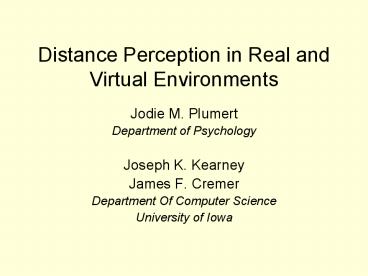Distance Perception in Real and Virtual Environments - PowerPoint PPT Presentation
Title:
Distance Perception in Real and Virtual Environments
Description:
People view a target, turn and walk a short distance, then point back at target. ... How closely did time-to-walk estimates correspond in real and virtual ... – PowerPoint PPT presentation
Number of Views:81
Avg rating:3.0/5.0
Title: Distance Perception in Real and Virtual Environments
1
Distance Perception in Real and Virtual
Environments
- Jodie M. Plumert
- Department of Psychology
- Joseph K. Kearney
- James F. Cremer
- Department Of Computer Science
- University of Iowa
2
Virtual Environments as Laboratories for Studying
Behavior
- Gaining widespread acceptance
- Driving (Uc, Rizzo, Shi, Anderson, and Dawson,
2004 - Lee, McGehee, Brown, Reyes,
in press) - Bicycling (Plumert, Kearney, Cremer, 2004)
- Navigating (Murray, Bowers, West, Pettifer,
Gibson, 2000 - Warren, Tarr, Kaebling, NEVLab
- Bowman, Davis, Badre, Hodges,
1999) - Advantages
- Near natural
- Highly controlled
- Safe
- Issues
- Are virtual environments real enough?
- How well do people perceive distance in VE?
3
Gap Acceptance in the Hank Bicycle Simulator
4
Perceiving Distance in the Real World
- How well do people perceive absolute distance
from self? (egocentric distance) - Visually guided judgments
- Matching depth/frontal intervals
- (Gilinsky, 1951, Harway, 1963, Loomis et al.,
1992) - People typically underestimate distance
- Visually directed action
- Walking to target with eyes closed
- (Loomis et al., 1992, Philbeck Loomis,
1997, Rieser et al., 1990) - People quite accurate up to 20 m.
- People tend to underestimate beyond 20 m.
5
Perceiving Distance in Virtual Worlds
- Distance perception with HMDs
- Triangulation (Loomis Knapp, 2003)
- People view a target, turn and walk a short
distance, then point back at target. - Pointing errors indicated that people undershot
distances. - Blindfolded walking (Whitmer Sadowski, 1998)
- Compared blindfolded walking in a real hallway
with blindfolded walking on a treadmill in a
virtual hallway. - Mean error similar, but unsigned relative error
greater in virtual than real environment. - People made greater errors in both environments
when they experienced the virtual environment
first. - Distance perception with large screen immersive
display systems (LSIDs)?
6
General Methods
- Real Environment
- Standard university building
- Targets were real people
- Virtual Environment
- Model of real environment
- Targets were billboard people
7
Virtual Environment
- Three 10X8 ft screens
- Rear projection
- Electrohome DLV projectors -1280x1024
pixels/screen - Square (Cave-like) configuration
- SGI Onyx with Infinite Reality Graphics
8
Experiment 1
- Subjects 24 undergraduates
- Procedure
- Baseline walking
- Timed normal walking to derive estimate of
walking speed - Distance estimates
- Presented 6 randomly ordered distances (20, 40,
60, 80, 100, and 120 ft) in each environment
(order counterbalanced) - Subjects estimated how long it would take to walk
to the target by starting and stopping a
stopwatch (without looking at the stopwatch) - Measures
- Actual time to walk
- Calculated expected time to walk each distance
from baseline walking speed - Estimated time to walk
- Elapsed time on a stop watch
9
Results
- Two primary questions
- How closely did time-to-walk estimates correspond
in real and virtual environments? - How closely did time estimates in the real and
virtual environments correspond to actual times?
10
Mean time-to-walk estimates Real environment
first
11
Mean time-to-walk estimates Virtual environment
first
12
Summary of Experiment 1
- Time-to-walk estimates were remarkably similar
across the real and virtual environments - Estimates were accurate up to 40-60 ft
- Time-to-walk estimates more distorted in both
environments when people experienced the virtual
environment first
13
Experiment 2 Sighted vs. blindfolded
time-to-walk estimates
- Rationale
- Replicate findings from Experiment 1
- Determine whether time-to-walk estimates differ
with and without vision - Subjects
- 16 undergraduates
- Procedure
- Baseline walking
- Sighted judgments same as Experiment 1
- Blindfolded judgments
- People viewed target for 5 s, put on blindfold,
and started stopwatch when they imagined starting
to walk
14
Mean sighted time-to-walk estimates
15
Mean blindfolded time-to-walk estimates
16
Summary of Experiment 2
- Again, time-to-walk estimates in the real and
virtual environment were very similar - Estimates accurate up to about 60 ft
- Time-to-walk estimates very similar with and
without vision
17
Conclusions
- Time-to-walk estimates are
- Highly similar in real and virtual environments
- Accurate for distances of 20-60 ft
- Underestimated for distances beyond 60 ft
18
Why the Difference?
- The Environment
- Time-to-walk measure
19
Why the Difference?
- The Environment
- Large Screen Immersive Display
- Large vertical field of view
- Wu , Ooi, He (2004) Show restricted VFOV
lead to underestimation of distance - Whitmer Sadowski (1998) suggest reduced
VFOV in HMDs degrades cues to distance - - Knapp Loomis (in press) Limited FOV of
HMD displays is not the cause of distance
underestimation in VE - - Creem-Regehr, Willemsen, Gooch, Thompson
(2003) Show restricted FOV does lead to
compression if head motions allowed - Helmet Weight
- Willemsen, Colton, Creem-Regehr, Thompson
(2004)
20
Why the Difference?
- Time-to-walk measure
- Differs from triangulation and blindfolded
walking in that it involves imagined rather than
real movement - New experiment to compare time-to-walk estimates
with blindfolded walking - Preliminary results show similar patterns of
error - Blindfolded walking 83 of real
- Imagined walking 73 of real
- Significantly different only at 20 ft
21
Acknowledgments
- NSF Support INT-9724746, EIA-0130864, and
IIS-0002535 - Students and staff for helping with this
research - David Schwebel Pete Willemsen
- Penney Nichols-Whitehead HongLing Wang
- Jennifer Lee Steffan Munteanu
- Sarah Rains Joan Severson
- Sara Koschmeder Tom Drewes
- Ben Fraga Forrest Meggers
- Kim Schroeder Paul Debbins
- Stephanie Dawes Bohong Zhang
- Lloyd Frei Zhi-hong Wang
- Keith Miller
Xiao-Qian Jiang - Geb Thomas































